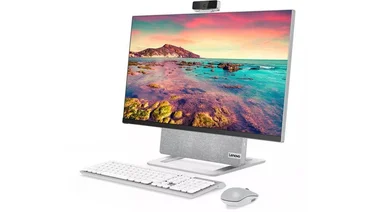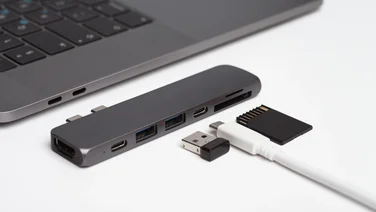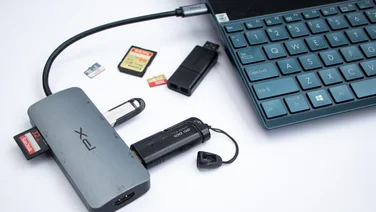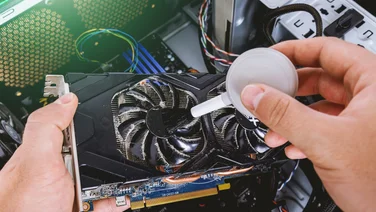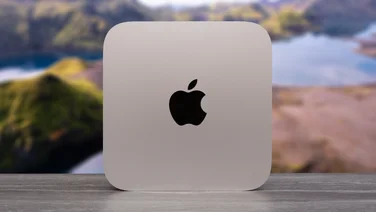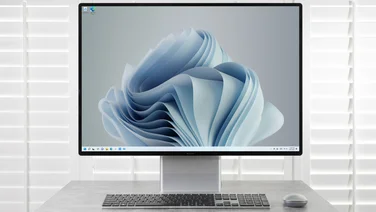To help us provide you with free impartial advice, we may earn a commission if you buy through links on our site. Learn more









- Way faster than previous models
- More, faster I/O interfaces
- Onboard power button
- Won’t fit existing cases
- Overkill for typical projects
The Raspberry Pi 5 follows a well-established template: it’s a cheap, lightweight, credit card-sized computer that’s powerful enough to run a Linux-based operating system and loaded with enough general-purpose connectors to fulfil more or less any role you might turn it to.
However, there are a lot of different Raspberry Pi boards to choose from. Although recent supply shortages have sometimes limited availability, the 2019 Raspberry Pi 4 is still on sale, along with previous generations dating back to 2014, in Model A and B variants – not to mention smaller, low-power Zero and Pico boards.
READ NEXT: Best laptop to buy
The new Raspberry Pi 5 is the cream of the crop. It keeps the classic compact format, but brings numerous hardware improvements that make it the fastest and most versatile Pi yet. In fact, it may well be more powerful than you need: an older, cheaper model will work just as well for most Pi projects.
Still, for what you get the Pi 5 is ridiculously affordable. If you’re seeking a tiny, dirt-cheap computer for a demanding project or a lightweight desktop role, it’s an almost irresistible choice.
Raspberry Pi 5 review: What you need to know
The Raspberry Pi 5 is arguably the most significant single-generation upgrade in the platform’s eleven-year history. For a start, it brings a huge boost in CPU power: the manufacturer claims its quad-core 2.4GHz Arm Cortex A76 processor is two to three times faster than the 1.8GHz A72 used in the Raspberry Pi 4. It’s supported by faster RAM too – either 4GB or 8GB or it – with LPDDR4X-4267 memory in place of the old LPDDR4-3200 chips.

The Raspberry Pi 5 also boasts upgraded graphics capabilities and faster storage, courtesy of the new RP1 I/O controller – the first piece of custom silicon designed by the Raspberry Pi Foundation.
Despite these changes, the Pi 5 should be compatible with all programs and scripts designed for earlier board versions, plus all the same peripherals and HATs (hardware attached on top). And you can be confident it will be supported for a good while to come: the Raspberry Pi Foundation has promised that the Raspberry Pi 5 will remain in production until at least January 2035.
Raspberry Pi 5 review: Price and competition
The Raspberry Pi 5 is currently available in 4GB and 8GB models, costing £59 and £79 respectively. Those are terrifically competitive prices – we’re talking just £4 more than the equivalent Raspberry Pi 4 Model B boards. Cheaper 1GB and 2GB versions of the Pi 5 are planned for the future.
At the same time, there are many older models still on sale at even lower prices. The Raspberry Pi 3 Model B+ comes with 1GB of RAM for £40, while the diminutive Raspberry Pi 3 Model A+ costs just £25 with 512MB of memory. The tiny Raspberry Pi Zero W with Wi-Fi and 512MB of RAM can be yours for a mere £15.
For the most lightweight projects, the Raspberry Pi Pico sells for £3.90 with 264KB of RAM – although since this board is based on the RP2040 microcontroller rather than a full-fat Arm CPU, it won’t run the full Raspberry Pi OS or support the full range of hardware add-ons.
If you’re seeking a Pi for a desktop role the obvious choice is the Raspberry Pi 400, which integrates a 4GB Raspberry Pi 4 into a neat keyboard case. Although not as fast as the Pi 5, it looks and feels appealingly like a classic 1980s personal computer, and costs a very reasonable £70.
Then again, if you’re not in a hurry, it might be smarter to wait for a machine that offers Raspberry Pi 5 internals in the same keyboard format. While no official announcement has been made, the manufacturer has dropped several hints that the Pi 500 is on its way; the only real question is how soon it will arrive.
Whichever model you choose, remember that Pi systems aren’t designed for aftermarket RAM upgrades, so make sure you pick a unit with enough memory for your needs.
Note too that, with the exception of the Pi 400, the prices quoted above are for bare boards. The Pi Hut’s Raspberry Pi 5 Starter Kit bundle includes an 8GB Pi, a power supply, a 32GB microSD card, a plastic case and a micro-HDMI-to-HDMI cable for £115. On top of that you’ll still need to find or buy a keyboard, mouse and display, unless you plan to use it entirely headlessly.
READ NEXT: Best budget laptop
Raspberry Pi 5 review: Design and features
Physically, the Raspberry Pi 5 looks quite similar to the Pi 4. Although the chips have been moved around, the end of the board is still dominated by a trio of metal risers, offering twin USB 2 and USB 3 sockets, plus a gigabit Ethernet port. Along the side of the board sit the familiar twin micro-HDMI connectors, each one supporting a 4K display at up to 60Hz, plus a USB-C power socket. On the top, the Pi’s trademark 40-pin GPIO connector remains, and the microSD card still pokes out of its slot on the underside.
Next to the microSD card slot, however, you may spot something new: the long-awaited power button, which lets you turn the system on and off without having to physically yank the cable. It’s a small thing, but it makes the Pi feel a lot more like a “real” computer.
The display and camera headers have been moved, and now sit next to the aft video socket. They’re still compatible with existing hardware modules, but the connectors themselves have been shrunk, so you’ll need new, smaller cables to make the connection. And, as the CAM/DISP label next to each one indicates, the connectors are now multi-purpose, so you can use them to run two cameras or two displays – or one of each.

This layout change means the old audio/composite jack socket has been ditched, so if you have a Pi project that needs analogue video output, you’ll need to solder your own connector into the holes provided or use an older Pi. On the plus side, the rearrangement of connectors has made space for a single-lane PCIe 2.0 header, providing a whole new way to connect high-bandwidth peripherals to the Pi.
One final update worth mentioning is a new battery connector nestled inconspicuously next to the power socket. The Pi 5 now features a real-time clock, and can be programmed to automatically wake up and go into deep sleep according to a schedule; if you plug in a lithium battery unit, it’ll remember the time and date even when there’s no external power.
All these changes mean that, while the Pi has the same 85 x 58mm dimensions as past models, it won’t fit properly into cases designed for earlier generations of the board. It also needs a new, meatier 27W power supply: a last-generation 15W power supply will work, but it may not provide enough power to keep things stable if you have lots of external peripherals connected.
You may also opt to drop a fiver on the Pi 5’s new snap-on active cooler, which mounts firmly onto the board via two spring-loaded plastic clips. This isn’t required, but it helps prevent thermal throttling under heavy load.
Raspberry Pi 5 review: Performance
I mentioned above that the Raspberry Pi 5 is purportedly as much as three times as fast as the Pi 4. I confirmed this by running a variety of benchmarks on both the new board and an older Raspberry Pi 4 Model B. I used 8GB models with passive cooling in both cases, and saw the following results:




The Sysbench test is a simple synthetic test that runs through a mathematical workload and measures the average number of calculations completed per second. Here the Pi 5 outpaced the older model by an impressive 80%. I also tried this test on a Raspberry Pi 3 Model A+ board, which scored 274, so we’re looking at close to a fourfold performance increase in two generations.
The Raspberry Pi 5 fared even better in the wide-ranging Geekbench benchmark. It proved 3.1 times as fast as the Pi 4 in single-core tasks, and 2.7 times as fast in multi-core mode. Interestingly, engaging the Pi 5’s active cooler didn’t make any significant difference to its scores – the Raspberry Pi Foundation suggests thermal throttling is only likely to become an issue for an uncooled Pi when the system is under “a heavy continuous load, such as rebuilding the Linux kernel”.

I also tried the BrowserBench suite of three web-based benchmarks, running in the Pi’s preinstalled Chromium browser. These were the intensive JetStream test, which tests JavaScript performance, MotionMark for graphical performance and Speedometer, which focuses on drawing and interacting with user elements such as drop-down lists. Again, the Raspberry Pi 5 raced ahead of the Pi 4, with results ranging from 2.6 times as fast in the JetStream test to a massive 6.4x speedup in MotionMark – a testament to the Pi 5’s upgraded GPU.

The difference isn’t merely academic. If you’ve used a previous Pi board interactively with a keyboard and mouse, you’ll definitely notice the Raspberry Pi 5 feels much snappier and more responsive.
I measured a boot-to-desktop time of 21 seconds for the new Pi, versus 39.4 seconds on the Pi 4. Opening Chromium took 4.1 seconds, down from 7.3 seconds. In practice, this is a machine that you can comfortably use for coding, education or general everyday productivity, without having to consciously make allowances for its performance.

There’s also scope to improve responsiveness further by using faster storage. The SD card I used for testing could only manage read and write speeds of around 18MB/sec, but the Pi 5’s new I/O controller supports SD data rates of up to 104MB/sec – twice as fast as the Pi 4 could handle.
For an even bigger boost, you could use an external SSD as your system drive. Where the Raspberry Pi 4 supported a total USB bandwidth of 4Gbits/sec, the Raspberry Pi 5’s USB 3 ports can both handle 5Gbits/sec at once. The forthcoming NVMe HAT will also give you the option of running an M.2 SSD at speeds up to 500MB/sec. You can switch to PCIe 3.0 mode to double the bandwidth, but the manufacturer doesn’t guarantee this will be glitch-free, so maybe don’t use it for critical storage.
READ NEXT: Best laptop for students
Raspberry Pi 5 review: Verdict
The Raspberry Pi 5 wholly eclipses the previous model in almost every aspect of performance, while costing just a few quid more. But before you get too dazzled, remember that Pi applications aren’t typically hardware-intensive.
Projects that focus on home automation, security, robotics, network services or data presentation probably won’t need a fraction of the power offered by this board. If you like to have multiple projects on the go, you’re better off buying a bunch of Raspberry Pi Zero units for the same total price.
Conversely, if you’re excited about the Raspberry Pi 5’s potential as a desktop system, you might want to wait for the Pi 500. That will be a neater way to get all the performance and connectivity of the Pi 5 in a self-contained unit, and it should cost barely any more than buying the board and keyboard separately.
Then again, the integrated design is less compact and versatile than the bare-board model – and there’s no word on when such a Pi will become available. If you’re at all interested in trying out the fastest, most flexible little hobbyist board ever, it’s hard to come up with a reason not to jump in and buy a Raspberry Pi 5 right now.

